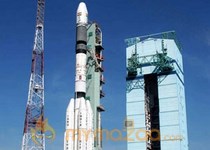With investigations into a leak in a rocket engine’s valve providing satisfactory results Wednesday, the Indian Space Research Organisation (ISRO) will celebrate Christmas by launching an advanced communications satellite, an official.
“The test results are satisfactory and the rocket’s launch is scheduled Dec 25. The launch countdown will begin 11 a.m. Friday,” S. Satish, a director at ISRO,said.
The rocket carrying the GSAT-5P satellite is expected to blast off from the second launch pad between 4 p.m.-4.15 p.m. Saturday.
The GSAT-5P is meant to retire the INSAT-2E satellite sent up in 1999 to ensure continuity of telecom, TV and weather services and was originally scheduled for Monday.
However, ISRO Sunday decided to postpone the launch of its geosynchronous satellite launch vehicle (GSLV) after it detected a leak in one of the valves of its Russian-made cryogenic engine.
The leak was detected during the pre-countdown tests, even as the 51-metre tall rocket was on the launch pad at Sriharikota, around 80 km from here.
ISRO officials had said some tests would be conducted Tuesday to gauge the extent of the valve leak. They said the tests and discussions with Russian scientists would go hand-in-hand at Sriharikota.
The Russians had supplied seven cryogenic engines, of which five were used in earlier GSLV launches.
Another ISRO official, speaking on condition of anonymity, said that the tests took around 30 hours and involved filling of liquid oxygen to check the valve. The liquid oxygen had to be later drained. The rocket’s ground systems had to be reconfigured for the tests.
The cryogenic engine is fired by liquid hydrogen as fuel and liquid oxygen as oxidizer.
According to the official, the valve leak was in the liquid oxygen system while all other valves were functioning well.
He said the tests started Tuesday at 4 a.m. and concluded at around 8 a.m. Wednesday.
“The activities undertaken were similar to the ones carried out for a regular rocket launch. Around 100 scientists and technologists were involved in tests,” he said.







